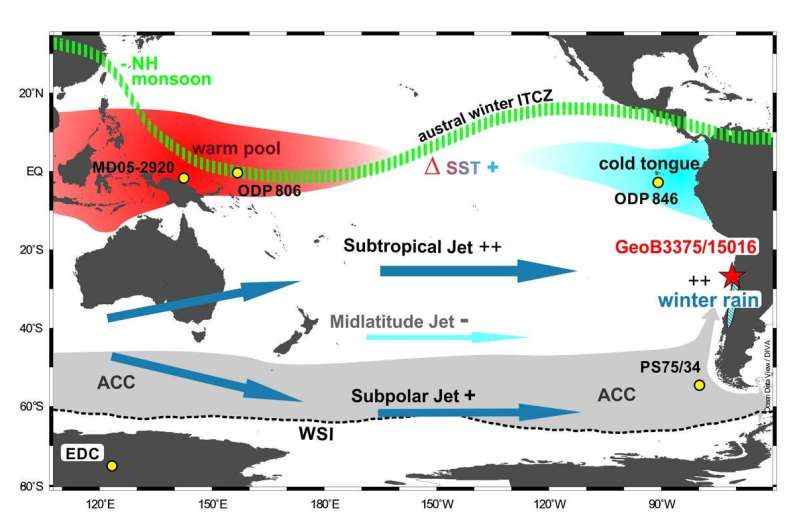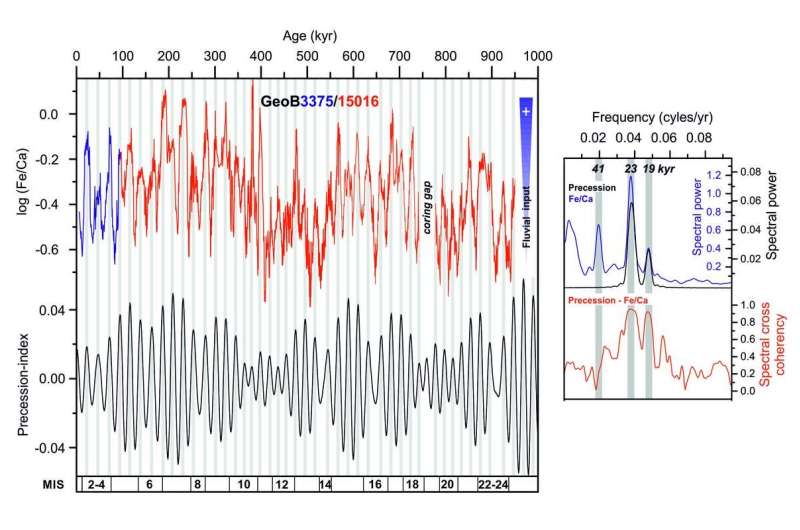Changes in high-altitude winds over the South Pacific produce long-term effects

In the past million years, the high-altitude winds of the southern westerly wind belt, which spans nearly half the globe, didn't behave as uniformly over the Southern Pacific as previously assumed. Instead, they varied cyclically over periods of ca. 21,000 years.
A new study has now confirmed close ties between the climate of the mid and high latitudes and that of the tropics in the South Pacific, which has consequences for the carbon budget of the Pacific Southern Ocean and the stability of the West Antarctic Ice Sheet. The study was prepared by Dr. Frank Lamy, a geoscientist at the Alfred Wegener Institute, Helmholtz Centre for Polar and Marine Research, together with researchers from Chile, the Netherlands, the U.S. and Germany, and has just been released in the Proceedings of the National Academy of Sciences of the United States of America (PNAS).
Changes in the southern westerly wind belt (SWW) produce fundamental effects on the intensity and position of the Antarctic Circumpolar Current, which is the world's largest ocean current and shapes ocean circulation worldwide. In this regard, one key factor is the wind-driven upwelling of CO2-rich deep-water masses, which, due to their comparative warmth, influences both the stability of the West Antarctic Ice Sheet and the carbon budget of the Southern Ocean.
On the basis of sediment cores, the team of researchers investigated precipitation-driven changes in sediment input in the Pacific off the coast of Chile. Assessing the past 1 million years, they identified what are known as precession cycles: changes caused by natural variations in the Earth's orbital parameters; in this case, cyclical changes in the rotation of its axis that occurred roughly every 21,000 years. Changes in these and other orbital cycles are generally considered to be a major driver for the alternation between extended glacials and interglacials over the past million years.

"At first it was hard to explain why the changes in the composition of continental sediments up to the southern margin of the Atacama Desert in northern Chile indicated pronounced precipitation variations over the 21,000 years, but less pronounced variations throughout the longer-term cycles of interglacials and glacials," recalls sedimentologist Helge Arz (Leibniz Institute for Baltic Sea Research Warnemuende).
The nature of the phenomenon was ultimately deciphered with the aid of American climate modeller John Chiang (University of California, Berkeley): "Our climate models show that the precipitation changes recorded in the sediment cores are connected to the configuration of high-altitude winds over the subtropical Pacific. In this regard, the division of the high-altitude wind changes into a northern, subtropical branch, a middle branch, and a subpolar branch in the course of the 21,000-year cycle."
"The study provides the first evidence of long-term changes in the high-altitude winds of the southern westerly wind belt over the South Pacific," explains Dr. Frank Lamy. "Our findings indicate closer atmospheric ties between the tropics and mid to high latitudes than in other sectors of the Southern Hemisphere, with consequences for global overturning circulation and the storage of atmospheric CO2 in the ocean."
The team's findings are also important with regard to understanding current and especially future large-scale climate mechanisms in the comparatively under-researched Southern Hemisphere. One crucial aspect is the coupling of the tropical Pacific with the source of the global climate phenomenon El Niño Southern Oscillation (ENSO) and the West Antarctic. The data show that the West Antarctic Ice Sheet's high sensitivity to ENSO in the Pacific sector, which can be seen in satellite observations made over the past few decades, is most likely also significant over much longer time scales.
"A change in the high-altitude winds over the South Pacific in response to the increased frequency and intensity of El Niño events that many climate models predict would reduce the stability of the West Antarctic Ice Sheet, while also negatively impacting CO2 storage in the South Pacific," says Lamy, putting the findings in perspective.
More information: Frank Lamy et al, Precession modulation of the South Pacific westerly wind belt over the past million years, Proceedings of the National Academy of Sciences (2019). DOI: 10.1073/pnas.1905847116
Journal information: Proceedings of the National Academy of Sciences
Provided by Alfred Wegener Institute

















